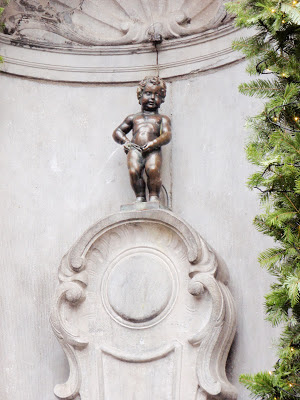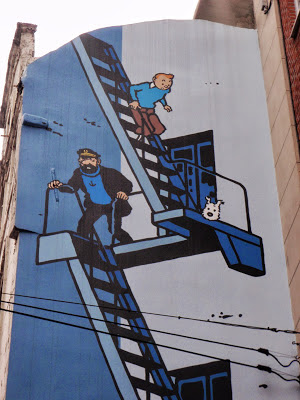The last two days of 2010 saw us visiting Brussels. I flew over to Belgium for a short trip from Scotland where I was spending a month with my family. Although I've been to Belgium a few times before (Bruges, Tournai) this was the first time I'd been to the country's capital.
We started our sight-seeing with the Royal Palace which was built on the site of the former Palace of the Dukes of Brabant, destroyed by fire in 1731. Building started in 1820 under the reign of King William, later it was modified in 1904 under Leopold II, who had it rebuilt in Louis XVI style. The side wings date from the 18th century and at the end of each wing is a pavilion. It isn't actually used as a royal residence however, as the king and his family live in the Royal Castle of Laeken on the outskirts of Brussels.
 |
| Royal Palace of Brussels |
In the nearby Montagne de la Cour street (Coudenberg) is the lovely Art Deco Old England building, designed by Paul Saintenoy in 1899 using glass and girded steel. Formerly a department store, since 2000 it has housed the restaurant of the Musical Instruments Museum (MIM).
 |
| Old England building, Montagne de la Cour street |
In the same street Paul Saintenoy also designed this corner house (see below) in 1895, mixing renaissance and gothic styles, and incorporating a sundial. It was – and still is – a pharmacy, first occupied by Charles Delacre, who believed that chocolate was the best curative. He sold so much of his chocolate that he soon opened a separate chocolate shop next door. Finally he relocated his factory to larger premises, but the pharmacy remained.
 |
| Delacre Pharmacy in Montagne de la Cour street |
Nearby is the Mont des Arts (Kunstberg) a geometric garden which was designed by landscape architect René Péchère. From here you can get some of the best views of Brussels.
 |
| Mont des Arts, with spire of Brussels City Hall in the background |
A short walk away is the Parc du Cinquantenaire (Jubelpark). Most of the buildings which surround the park in a U-shape were commissioned by the Belgian government under the patronage of King Leopold II for the 1880 National Exhibition commemorating the fiftieth anniversary of Belgian independence.
 |
| interesting clock, near Parc du Cinquantenaire (note the bell on top) |
Next we headed to Brussels' famous Grand Place (Grote Markt), passing some interesting shopfronts along the way.
The Grand Place is known as one of Europe's most beautiful city squares, and has been classed as UNESCO World Heritage since 1998.
 |
| partial view of Brussels City Hall |
 |
| The Maison des Ducs de Brabant (Hertogen van Brabant) is actually one facade covering seven guildhouses |
The earliest written reference to the square dates from 1174.
 |
| some of the other guildhalls on Grand Place |
Belgium's first Protestant martyrs, Hendrik Voes and Jan Van Essen, were burned by the Inquisition here in 1523.
 |
| Brussels City Museum, located in the Maison du Roi (Broodhuis) building |
In August 1695 during the War of the League of Augsbourg, most of the houses on the Grand-Place were destroyed during a bombardment of flaming canon balls by French troops. Only the facade and the tower of the City Hall, which were the target, and some stone walls resisted. The houses surrounding the square were quickly reconstructed, in stone this time, by the various guilds. These are the buildings which are still standing today.
 |
| a life-sized nativity creche in Grand Place |
Next we visited Manneken Pis, which means 'Little Man Pee' in Marols, a Dutch dialect spoken in Brussels. One of Brussels' most famous landmarks, there are many stories about the statue's meaning. It is believed to have been inspired by a child who, while in a tree, found a special way to drive away invading troops. Another story goes that a father was missing his child and made a declaration to the city that when he found him he would build a statue of him, doing whatever it was that he was doing. It has also been said a witch turned him to stone for peeing on her property. None is definitively true. The original statue was erected in 1388, and the current statue in 1618 or 1619.
 |
| Manneken Pis, a small bronze fountain sculpture only 61 cm high |
 |
| a festive shopfront near Manneken Pis |
Belgium is of course famous for its comic strips. Just a few steps away from Manneken Pis, in Rue de l’Étuve (Stoofstraat) a monumental fresco depicts Tintin, Snowy and Captain Haddock in The Calculus Affair.
 |
| Tintin-themed fresco, Rue de l'Etuve |
 |
| interesting building |
In the Sablon district of Brussels is Petit Sablon Square. In the middle of the square is a fountain with a statue of Counts Egmont and Horne, who were symbols of resistance to Spanish tyranny in the 16th century.
 |
| Counts Egmont & Horne statue, Petit Sablon Square |
The square is surrounded by Gothic columns with bronze statues on top. They represent 48 traditional trades (goldsmiths, weavers, tailors, etc).
 |
| Statue representing saddlers & coach builders (holding a carriage shaft and with a saddle on shoulder) |
At N° 9 Petit Sablon Square this early 17th century building with crow-stepped gables was formerly an inn called Au Roy d'Espagne:
 |
| Au Roy d'Espagne former inn |
Also bordering the square is Our Lady of Sablon, a late Gothic church dating from around 1400 to about 1594. It was paid for by the city's Guild of Crossbowmen, who called it optimistically Notre-Dame des Victoires (Our Lady of Victories), and it was their guild church.
 |
| Notre Dame du Sablon church (note three trade statues in front) |
Our final visit was to the Atomium, which was originally built for the 1958 World's Fair, and designed by the engineer André Waterkeyn.
 |
| The Atomium, an iconic Brussels structure |
It has nine stainless steel spheres and stands 102 metres tall. It forms the shape of a unit cell of an iron crystal magnified 165 billion times.
 |
| looking at the Atomium from underneath |
Useful links:
Suggested reading:




No comments:
Post a Comment